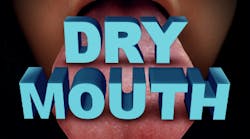The 5 questions you should ask first if you suspect your patient has dry mouth
By Kris Potts, RDH, FAADH
1.Are they aware of it?
Many times, an individual is not even aware their salivary flow has decreased, because it is not yet causing them discomfort. Similar to wondering why they should have those third molars extracted because they don’t hurt—at least notyet!
As dental health professionals, we are often in a position to be the first to see signs and indicators that there is something amiss with their salivary flow, buffering capacity, or consistency. Many times by the time they realize there is an issue, their salivary function has already decreased by up to 70%! Are you utilizing salivary diagnostics?
2.What is the underlying cause?
Polypharmacy? Systemic illness? Oncology treatment? Poor nasal breathing? The answer can play a large role as to which products you recommend. There are many on the market, but each address different issues. For example, if an individual has undergone oncology treatment and the salivary glands have been rendered nonfunctional, a product that stimulates salivary flow is not going to provide the outcome you are seeking.
3.What is the severity?
Is it annoying or uncomfortable? Painful? Affecting their quality of life? Their nutrition? There are certain key factors to look for and referring to a resource such as the Challcombe Scale will help you make a specific diagnosis for the patient record which can be helpful when submitting for benefit claims for treatments.
4.Are there co-morbidities present?
Are they experiencing rampant or recurrent decay? Is there a heavy bacterial load or infection present? Oral mucositis? Malnourishment? Those issues need to be addressed on an individual basis as well as the relief of symptoms. Some products may address both; many may need an additional recommendation or therapy. Oral mucositis can be prevented, mitigated, and of shorter duration when the correct products are used properly.
5.What is the ultimate goal?
The answer to this lies in the answers to the preceding questions. Is the goal simply relief from symptoms? There are many products on the market, both prescription and over-the-counter that range from adequate to exceptional at providing symptom relief.
Is the goal to coat and protect the oral mucosa? There are products available that mimic the role saliva plays in our overall health (salivary substitutes/sialagogues) and assist in preventing opportunistic infections from damaging the oral mucosa. These are required mostly by those who have total hyposalivation, often caused by head and neck radiotherapy.
Is the goal caries management? A sugar-free product with additional calcium, fluoride and a neutral pH would be indicated in this situation. An additional protocol to reduce bacterial load, treat an existing infection, remineralize tooth structure and nutritional counseling can be offered as well.
It is not a matter of a “good” product or a “bad” product. It is more a matter of offering choices and alternatives suited to personalized needs rather than a “one size fits all” approach. Some individuals prefer “all natural” or holistic remedies. Others may have allergies or contraindications for certain ingredients. Some, due to the basic cause of the xerostomia, may have sensitivities to certain flavors or textures.
What works amazingly well for one person may be totally unpalatable to another resulting in underutilization and poor outcomes. The issue is often more disruptive at night as opposed to during the day. Multiple therapies may be indicated and fortunately for us all, today’s available therapies are plentiful from which to choose.
If you would like a comprehensive list of available products and their indications or to book a CE course on oral prehabilitation for the oncology patient, contact [email protected].
Kris Potts, RDH, FAADH, is a clinician, speaker, and author. She is the owner/CEO of Oral Health Promotion Strategies, LLC. Her website is krispottsrdh.com, and can be contacted at [email protected]. Kris has been a clinical hygienist for over 32 years, a member of the American Dental Hygienists’ Association, fellow and accredited provider with the American Academy of Dental Hygiene, and member of the American Academy for Oral Systemic Health. She is a past president of the Texas Dental Hygienists’ Association. Kris offers information to a cross section of medical and dental offices across the United States and dental topics to consumer, advocacy, support, and special interest groups. She also serves as a regional education manager for the central U.S. for Spry/Xlear products.






